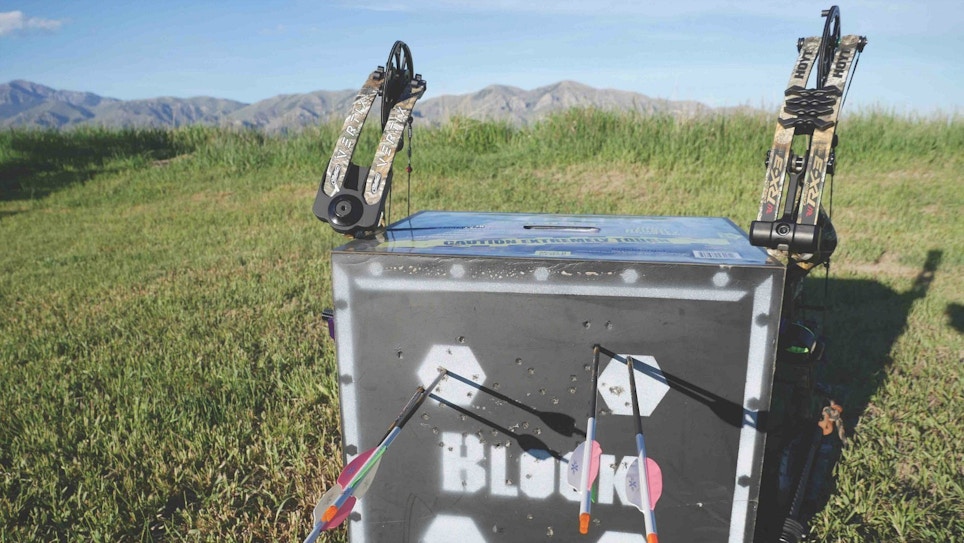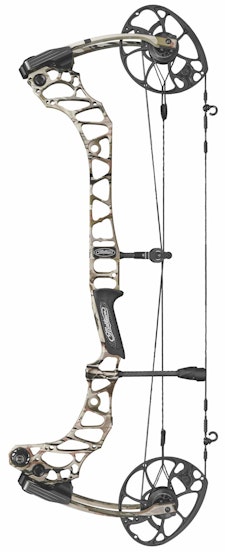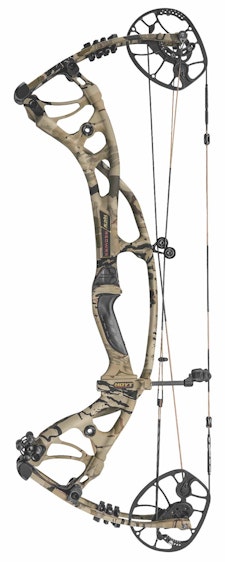
Shooting the Mathews Vertix and Hoyt RX-3 side by side, you quickly feel the differences between the bows.
For this matchup, we have two short axle-to-axle bows. These two compact bows have several similar key specifications, including axle-to-axle length, brace height and speed. However, shooting each bow provides a vastly different experience. Let’s get right into it.
Mathews Vertix
The Vertix is a compact bow with a 30-inch axle-to-axle length and a 6-inch brace height. Like its predecessor the 28-inch Triax, the Vertix comes equipped with the Crosscentric cam, upgraded with Mathews’ new Switchweight Technology for 2019. With today’s high-performance bows, it is not often that we see something truly innovative, but Mathews “brought it” with this technology advancement. The Switchweight system allows you to change the poundage range on the bow by simply changing a module. This means the same bow can be set from 50 to 75 pounds just by changing the modules, no limb change needed. This makes it handy to shoot your bow at various draw weights during different seasons. And you can do so while keeping your bow at peak efficiency. With this new feature, significant poundage and draw length adjustments, as well as letoff changes, are easily made without the aid of a bow press.
Also new this year is the Redesigned Engage grip. The Engage grip is more ergonomic and has more angle than past Mathews models. Although many Mathews shooters have not had issues with the more flat grip in the past, it has been a discomfort for some shooters. The Engage grip will likely remedy that issue for many. The grip itself is made of a rubberized material and has some texture to it, making it warmer on cold mornings and likely easier to keep your grip in varying elements.
Another unique feature is the custom dovetailing on the back of the bow’s riser to accommodate the special Mathews Integrate QAD rest. This system locks this specific rest in without the worry of downward pressure moving your rest like can happen with standard rests. That being said, there are regular mounting holes for your favorite rest as well.
Overall, the look and feel of the Vertix is distinctly similar to that of last year’s flagship, the Triax. Both have the same wide, stable stance on the limb pockets and split limbs. The Vertix has the riser cages on top and bottom, reverse-assist cable guides and the 3-D damping system. The real difference between the Triax and the Vertix are mentioned above, as well as a few more cutouts in the riser due to the 2-inch longer riser.
Mathews Vertix Specs
- BRACE HEIGHT: 6 inches
- AXLE-TO-AXLE: 30 inches
- WEIGHT: 4.67 pounds
- LETOFF: 80 to 85 percent
- PUBLISHED SPEED: 343 fps
- DRAW WEIGHT: 60, 65, 70, 75
- DRAW LENGTH: 26 to 30.5 inches
- FINISHES: Optifade Elevated II, Optifade Subalpine. Ridge Reaper Forest, Ridge Reaper Barren, Realtree Edge, Stone and Black
- MSRP: $1,099
- CONTACT: www.mathewsinc.com
Mathews Vertix Field Testing
I have never been a short axle-to-axle bow guy and usually shoot bows in the 33- to 35-inch range, so I was unaware of some of the challenges that came with setting up the bow. When installing the Ripcord LOK rest, I had to adjust the containment arm so it would mount properly without touching the cable guard. This is not a big issue, but I just thought it was notable to say some adjustment may be required with certain rests. The more worrisome problem for me was my peep height. I generally have about 7.25 inches between my nock and the center of my peep. This measurement put me up extremely close to the cam serving. I realize my measurement may be long, but if it had been any longer, I would not have been able to mount my peep correctly.
Once I got over this hurdle, I had the bow shooting bullet holes through paper within a few shots. For me, this was just inside factory center shot recommendations. While firing a few test arrows, I Immediately noticed that this was easily the most dead-in-hand bow I had ever fired, and it’s “next level” quiet. Mathews credits this to its 3D Damping system. I am not sure what it is exactly that contributes to the low level of recoil on the shot, or if it is a combination of things, but I do know this bow has absolutely no recoil when fired.
The oversized Crosscentric cam provides a smooth draw cycle, and the bow breaks over to a nice back wall, holding there well. I found the bow to be accurate, and in no time at all I was stacking arrows out to 50 yards.
Simply put, the Vertix is one of the smoothest shooting bows I have ever fired. Personally, with my longer draw length, the peep being so close to the cam, and my pull toward longer axle-to-axle bows, I am interested in trying out the slightly longer Traverse. With all of the same features of the Vertix and an additional 3 inches of length, I think it would fit my style a little better. That being said, I know many archers who are accustomed to shooting 30-inch and even shorter bows, and I am positive that for most this bow would be a perfect fit.
Hoyt RX-3
A few others have dabbled in the carbon game, but Hoyt has long been the king in top-end carbon bows. This year’s RX-3 is no exception. Right out of the box this 30.5-inch, compact bow is a real looker. Finish is great and its new parallel-track carbon-tube design provides a super cool look as the tubes are offset horizontally. This makes the stance of the riser wider; Hoyt claims that alone makes the riser much more rigid, as well as helping to direct shock away from the grip. Another new feature of this riser is the weight forward design, where the majority of the weight is ahead of the grip, giving more balance to the shooter throughout the shot.
The new Hoyts are also loaded with other new features like the ZT Pro Cam. The most unique quality of this cam is the patent-pending, split cable system that balances the side-to-side load. In their words, “This helps eliminated lateral nock travel and eliminates the need for a flexible cable guard.”
Another feature you will notice this year is the Hole Shot string vibration dampening system. This is a rubberized circle that as the bow is settled into the back wall expands and when fired it contracts to help eliminate string vibration. Also on board are the all new Shock Pods, redesigned StealthShot string suppression system and Hoyt’s limb shocks. The RX-3 was engineered top-to-bottom to be ultra-quiet and smooth.
On top of those features, the most notable new feature is the new Adjustable Grip System. Bow companies are starting to realize more and more that all archers aren’t the same. This grip system addresses the issue head on by allowing individual shooters to adjust the grip laterally to help with tuning and center shot alignment that matches the shape and grip style of individual archers.
Hoyt RX-3 Specs
- BRACE HEIGHT: 6 inches
- AXLE-TO-AXLE: 30.5 inches
- WEIGHT: 3.9 pounds
- LETOFF: Unspecified
- PUBLISHED SPEED: 342 fps
- DRAW WEIGHT: 40, 50, 60, 65, 70 and 80
- DRAW LENGTH: 25 to 28 inches or 27 to 30 inches
- FINISHES: Realtree Edge, Kuiu Verde 2.0, Optifade Subalpine, Optifade Elevated II, Ridge Reaper Barren, Storm, Black Out, Realtree Edge Bone Collector, Black Out Bone Collector, Ridge Reaper Barren Cameron Hanes Edition and Black Out Cameron Hanes Edition
- MSRP: $1,699
- CONTACT: www.hoyt.com
Hoyt RX-3 Field Testing
I had zero issues mounting the Black Gold 5-pin sight or the Ripcord LOK rest, but I ran into the same issue on the short RX-3 as I did on the Vertix; the short axle-to-axle bow had my peep right up against the Hole Shot system that rests just below the top cam. I was able to install my peep, but going much higher wouldn’t have been an option.
When I got to paper-tuning, I did have a small left tear. I wanted to test out Hoyt’s theory on its adjustable grip, and with a couple of minor adjustments and tweaking, I was able to get a bullet hole while keeping the rest at the factory center shot recommendation. Doing so was nice, considering I am one of those nitpicky types who likes to have the rest right in the middle.
The ZT Pro Turbo Cam loads up fairly quickly, but the bow still has a smooth draw, breaking over nicely. The back wall, although more solid than past models, isn’t quite as rock solid as some compounds. I find this to be a non-issue when I spend significant time shooting one bow, but it is noticeable when going back and forth between bows. I found the RX-3 to have more of a “speed bow” feel. With its smaller cams, it draws a little more stiffly, and at full draw it feels like it needs a little more pull against the wall.
I did feel a slight buzz with the RX-3, but I do mean slight. Accuracy was superb with the new Hoyt, and I found myself quickly having to shoot at different spots to keep from hitting my other arrows, even at extended ranges.
Final Thoughts
Testing these two bows side by side made it crystal clear the only way to find the right bow is to shoot every bow you can. As mentioned previously, these two bows are exceptionally similar, however, their feel is vastly different. Both bows are compact, maneuverable and would be a joy to handle in the field. I am confident in the accuracy and smooth operation of these two 30-inchers and encourage you to shoot them yourself.
How We Test
- Each bow is set at a 29-inch draw length and 70 pounds of draw weight. The string is equipped with a RAD 3⁄16-inch peep sight and D-loop. The accessories installed include a Ripcord Lok rest, Black Gold Rush 5-pin sight and a Stokerized stabilizer. Bows are paper tuned and shot, by hand, through a ProChrono Digital Chronograph.
- Bows are sighted-in from 20 to 60 yards with a 29.5-inch Black Eagle X Impact Arrow, fletched with Vanetec 3-inch vanes and fitted with a 125-grain point for a total weight of 475 grains. All bow work requiring pressing is performed with a Last Chance Archery, EZ Green Press.








